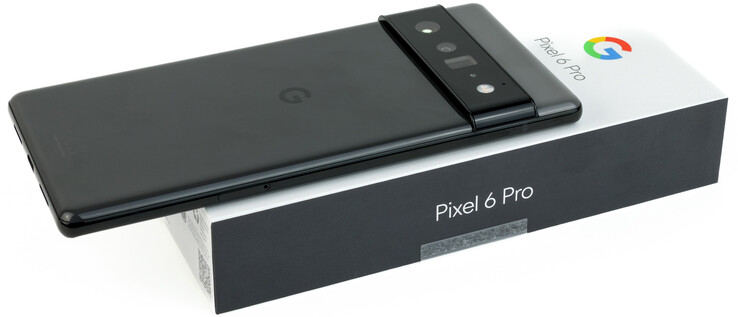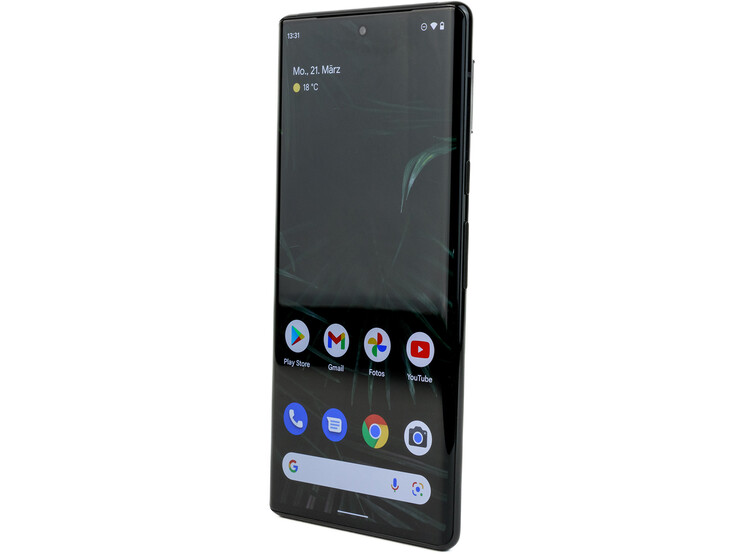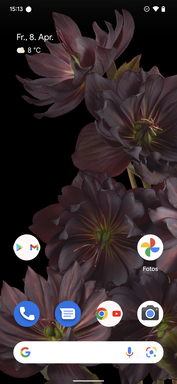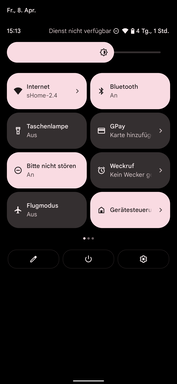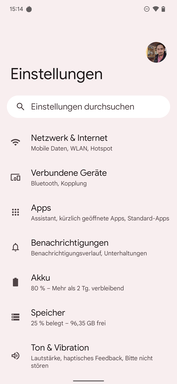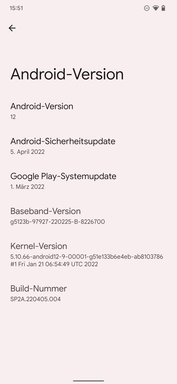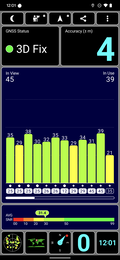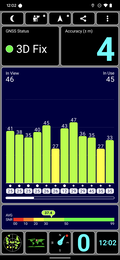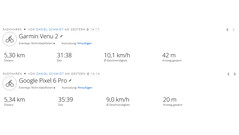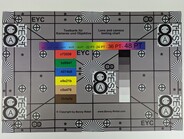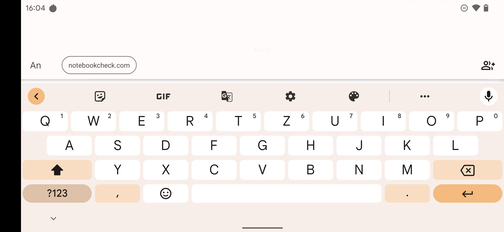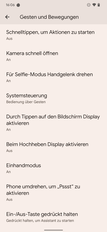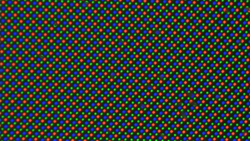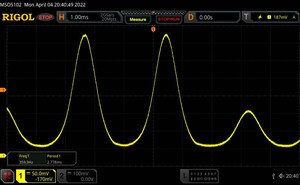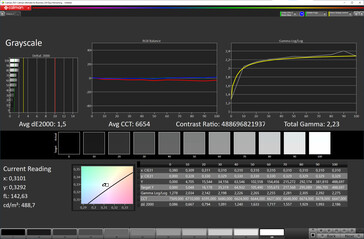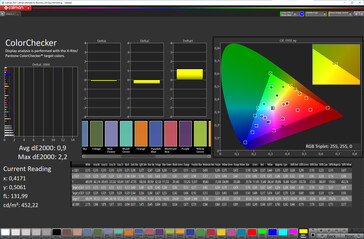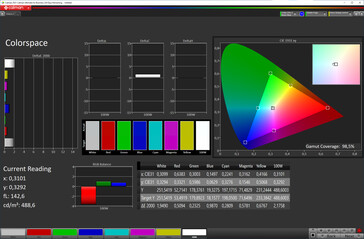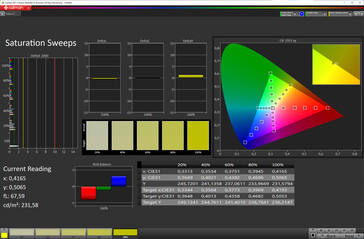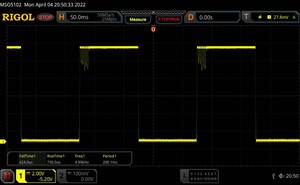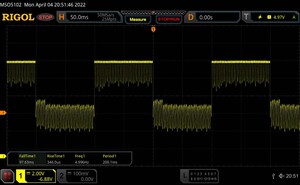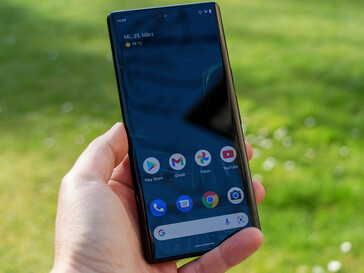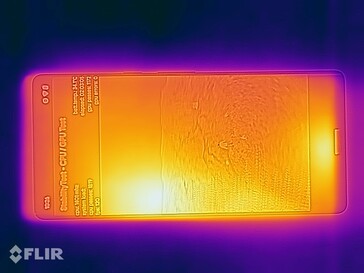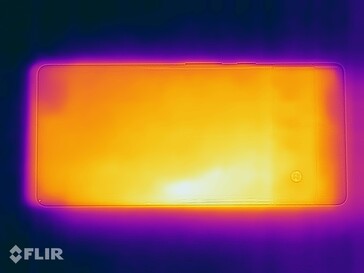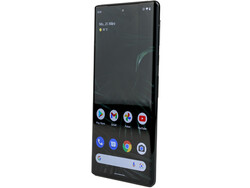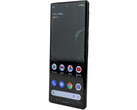Google Pixel 6 Pro Review - Eye Candy with Vanilla Android
Google’s Pixel 6 Pro is the better equipped competitor to the Pixel 6. It features a larger display with both a higher resolution and a higher refresh rate, a larger battery, and more RAM. The camera setup looks very similar at first glance but unlike the Pixel 6 the Pixel 6 Pro comes with an optical zoom.
In Europe, the device is available in two trims, one with 128 GB and one with 256 GB of storage starting at $899 and $999, respectively. US customers are also treated to a 512 GB storage option for another $100.
Potential Competitors in Comparison
Rating | Date | Model | Weight | Drive | Size | Resolution | Price |
|---|---|---|---|---|---|---|---|
| 89.2 % v7 (old) | 04 / 2022 | Google Pixel 6 Pro Tensor, Mali-G78 MP20 | 210 g | 128 GB UFS 3.1 Flash | 6.70" | 3120x1440 | |
| 88.9 % v7 (old) | 05 / 2022 | Samsung Galaxy S22+ Exynos 2200, Xclipse 920 | 196 g | 128 GB UFS 3.1 Flash | 6.60" | 2340x1080 | |
| 87.6 % v7 (old) | 02 / 2022 | Xiaomi 12 Pro SD 8 Gen 1, Adreno 730 | 204 g | 256 GB UFS 3.1 Flash | 6.73" | 3200x1440 | |
| 90.8 % v7 (old) | 10 / 2021 | Apple iPhone 13 Pro A15, A15 GPU 5-Core | 203 g | 256 GB NVMe | 6.10" | 2532x1170 | |
| 89.2 % v7 (old) | 04 / 2022 | Oppo Find X5 Pro SD 8 Gen 1, Adreno 730 | 221 g | 256 GB UFS 3.1 Flash | 6.70" | 3216x1440 |
Case – Not Much Heavier Than the Pixel 6
Despite its larger display and larger battery the Google Pixel 6 Pro is only slightly larger and with an additional 3 g (0.1 oz) only ever so slightly heavier than the Pixel 6. Due to its slightly narrower display bezels and the curved glass along the sides we also find an improved display-to-body ratio of 89 %.
Our review unit’s metal frame was polished and thus as susceptible to fingerprints and smudges as the Corning Gorilla Glass Victus covering both sides. Build quality was good overall, with even and narrow gaps and only minor creaking when warped.
The Google Pixel 6 Pro is IP68-certified against ingress of dust and water and available in three colors: Stormy Black, Cloudy White, and Sorta Sunny.
Connectivity – Pixel 6 Pro with Fast USB
The Google Pixel 6 Pro features a fast USB 3.2 Gen 1 USB port for fast data transfers and USB OTG. Unfortunately, it does not support wired display output. Bluetooth 5.2 and NFC are supported.
In general, the Pixel 6 Pro follows its predecessor’s minimalist approach. It lacks support for microSD storage expansion, a notification LED, an IR blaster, an FM radio receiver, and more.
Software – Long Update Cycle including Android 15
The Google Pixel 6 Pro comes with Android 12 by default and, like the Pixel 6, a long update cycle with a minimum of three years of feature upgrades plus an additional two years of security updates for a total of five years.
The 6 Pro supports all the well-known Pixel features, and there are no third-party apps to be found preloaded out of the box.
Communication and GNSS – Fast Wi-Fi with Wi-Fi 6 and VHT160
The Google Pixel 6 Pro supports all modern communication standards, including Bluetooth 5.2, NFC, and 5G Sub6.
While in theory its Wi-Fi modem supports Wi-Fi 6E in practice it turned out to be very unstable and unreliable with regular signal loss when connected to our Asus ROG Rapture GT-AXE11000 reference router, something Google will need to address. Restricting ourselves to Wi-Fi 6 was more reliable and extremely fast thanks to support for VHT160.
| Networking | |
| iperf3 receive AXE11000 | |
| Google Pixel 6 Pro | |
| Xiaomi 12 Pro | |
| Samsung Galaxy S22+ | |
| Oppo Find X5 Pro | |
| Average of class Smartphone (52 - 1721, n=177, last 2 years) | |
| iperf3 transmit AXE11000 | |
| Google Pixel 6 Pro | |
| Xiaomi 12 Pro | |
| Samsung Galaxy S22+ | |
| Oppo Find X5 Pro | |
| Average of class Smartphone (49.8 - 1828, n=177, last 2 years) | |
| iperf3 transmit AXE11000 6GHz | |
| Samsung Galaxy S22+ | |
| Average of class Smartphone (508 - 1945, n=94, last 2 years) | |
| iperf3 receive AXE11000 6GHz | |
| Samsung Galaxy S22+ | |
| Average of class Smartphone (451 - 1870, n=94, last 2 years) | |
| iperf3 transmit AX12 | |
| Apple iPhone 13 Pro | |
| iperf3 receive AX12 | |
| Apple iPhone 13 Pro | |
The Pixel 6 Pro supports all common location services and managed to obtain satellite lock at a high accuracy level indoors.
On our usual bicycle trip around the block, we compared its accuracy to that of a Garmin Venu 2. The Pixel 6 Pro turned out to be not particularly accurate with several deviations between the recorded track and our actual location. That said it was still good enough for everyday navigation.
Telephony and Call Quality
In terms of telephony the Google Pixel 6 Pro is very similar to the Pixel 6 with dual SIM support via a single Nano SIM as well as an eSIM. It supports both VoLTE as well as Wi-Fi Calling.
Call quality was very good, at least when using the unit’s earphone. Voice transmissions were clear and natural with good ambient noise cancellation a few seconds into the conversation. The device’s three microphones and software algorithms did a fantastic job in this regard.
On speakerphone, however, we found the Pixel 6 Pro to sound slightly muddled and hollow with a somewhat limited microphone range.
Cameras – Improved Pixel 6 Setup
Both current Pixel phones feature very similar camera setups. The only difference is the optical zoom as well as a higher-resolution front-facing camera on the Pixel 6 Pro. Unfortunately, the latter still lacks an autofocus but offers a higher level of details thanks to its higher resolution. It also supports 4K@30FPS or FHD@60FPS video recording.
Both the main camera and the ultra-wide-angle lens are identical to the Pixel 6, and you can find more details on these two cameras in our Pixel 6 review. The additional 4x periscope zoom allows for a total digital zoom of 20x, at least according to Google. In reality, zoom levels of less than 8x continue to use the main lens and only shift to the periscope lens above 8x. Keep in mind that this is only true of the main object is no further away than 3 ft. The results are decent albeit not usable for large printouts anymore.
Videos are recorded in UHD at 60 FPS with zoom limited to 7x. You can, however, also utilize the camera’s full zoom capabilities if you either lower the FPS or the video resolution.
Pixel 6 Pro zoom (left to right): 2x, 4x, 10x, and 20x zoom
Image comparison
Choose a scene and navigate within the first image. One click changes the position on touchscreens. One click on the zoomed-in image opens the original in a new window. The first image shows the scaled photograph of the test device.
HauptkameraHauptkameraUltraweitwinkel5-facher ZoomLow-Light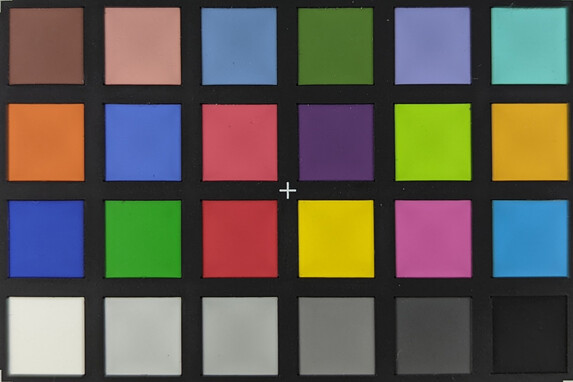

Accessories and Warranty – Pixel Smartphone without Charger
The Google Pixel 6 Pro comes with a USB-C cable, a USB OTG dongle (USB-C to A), and a SIM tool. Compatible wired or wireless chargers have to be purchased separately.
Unlike European models units sold in the United States are limited to just 12 months of warranty with optional warranty extensions for up to two years available for $199 or up to three years for a monthly fee of $9.
Input Devices & Handling – No Face Detection
The Google Pixel 6 Pro’s capacitive touchscreen worked flawlessly and felt very smooth. It can detect up to ten inputs simultaneously and turned out to be very accurate overall. The built-in vibration motor was very firm and crisp.
The device features an in-display fingerprint reader that while very fast was not particularly accurate and reliable. Face detection is not available.
Display – LTPO OLED with up to 120 Hz
The 6.7-inch display runs at a native QHD+ resolution that cannot be lowered in software. Furthermore, this LTPO OLED display supports adaptive refresh rate switching between 60 and 120 Hz.
Illumination was very even and consistent, and the display reached a peak brightness of 814 nits on an all-white image and up to 1,053 nits (center) in our APL50 test with evenly distributed black and white tiles. With the ambient light sensor disabled maximum brightness is limited to just 489 nits.
PWM flickering was identical to the Pixel 6 with uneven flickering between 176.1 and 376.6 Hz at minimum brightness and a more flatlined amplitude with increasing levels of brightness. Nevertheless, sensitive users might experience issues with the device, especially since DC dimming is not supported.
| |||||||||||||||||||||||||
Brightness Distribution: 97 %
Center on Battery: 794 cd/m²
Contrast: ∞:1 (Black: 0 cd/m²)
ΔE ColorChecker Calman: 0.9 | ∀{0.5-29.43 Ø4.78}
ΔE Greyscale Calman: 1.5 | ∀{0.09-98 Ø5}
98.5% sRGB (Calman 2D)
Gamma: 2.23
CCT: 6654 K
| Google Pixel 6 Pro LTPO-OLED, 3120x1440, 6.7" | Samsung Galaxy S22+ AMOLED, 2340x1080, 6.6" | Xiaomi 12 Pro AMOLED, 3200x1440, 6.7" | Apple iPhone 13 Pro OLED, 2532x1170, 6.1" | Oppo Find X5 Pro AMOLED, 3216x1440, 6.7" | |
|---|---|---|---|---|---|
| Screen | -38% | -8% | 8% | 1% | |
| Brightness middle (cd/m²) | 794 | 1090 37% | 959 21% | 1050 32% | 746 -6% |
| Brightness (cd/m²) | 801 | 1097 37% | 977 22% | 1058 32% | 744 -7% |
| Brightness Distribution (%) | 97 | 98 1% | 96 -1% | 98 1% | 97 0% |
| Black Level * (cd/m²) | |||||
| Colorchecker dE 2000 * | 0.9 | 2.5 -178% | 1.1 -22% | 1 -11% | 0.9 -0% |
| Colorchecker dE 2000 max. * | 2.2 | 3.8 -73% | 3.1 -41% | 2.4 -9% | 1.6 27% |
| Greyscale dE 2000 * | 1.5 | 2.3 -53% | 1.9 -27% | 1.5 -0% | 1.6 -7% |
| Gamma | 2.23 99% | 2.04 108% | 2.22 99% | 2.2 100% | 2.23 99% |
| CCT | 6654 98% | 6492 100% | 6498 100% | 6504 100% | 6499 100% |
* ... smaller is better
Screen Flickering / PWM (Pulse-Width Modulation)
| Screen flickering / PWM detected | 360.5 Hz | ||
The display backlight flickers at 360.5 Hz (worst case, e.g., utilizing PWM) . The frequency of 360.5 Hz is relatively high, so most users sensitive to PWM should not notice any flickering. However, there are reports that some users are still sensitive to PWM at 500 Hz and above, so be aware. In comparison: 53 % of all tested devices do not use PWM to dim the display. If PWM was detected, an average of 8108 (minimum: 5 - maximum: 343500) Hz was measured. | |||
Fixed zoom with various brightness settings
We found the color profile “Natural” to produce the most accurate colors. Keep in mind that it is limited to the smaller sRGB color space. If you want to use the larger DCI-P3 color space, you need to enable either the “Adaptive” or “Vivid” color modes. Both feature a very similar white balance with different levels of saturation.
Display Response Times
| ↔ Response Time Black to White | ||
|---|---|---|
| 1.354 ms ... rise ↗ and fall ↘ combined | ↗ 0.73 ms rise | |
| ↘ 0.624 ms fall | ||
| The screen shows very fast response rates in our tests and should be very well suited for fast-paced gaming. In comparison, all tested devices range from 0.1 (minimum) to 240 (maximum) ms. » 6 % of all devices are better. This means that the measured response time is better than the average of all tested devices (20.2 ms). | ||
| ↔ Response Time 50% Grey to 80% Grey | ||
| 0.692 ms ... rise ↗ and fall ↘ combined | ↗ 0.346 ms rise | |
| ↘ 0.346 ms fall | ||
| The screen shows very fast response rates in our tests and should be very well suited for fast-paced gaming. In comparison, all tested devices range from 0.165 (minimum) to 636 (maximum) ms. » 2 % of all devices are better. This means that the measured response time is better than the average of all tested devices (31.6 ms). | ||
Outdoor usability is very good overall but not as good as with other devices, such as for example the Galaxy S22 Plus.
As expected, viewing angles are superb with only a minor decrease in brightness and no visible color tint at extreme angles.
Performance – Pixel Smartphone with Google SoC
Like its sibling the Google Pixel 6 Pro features Google’s own Google Tensor SoC. It has access to 12 GB of LPDDR5 RAM, the Titan M2 security chip, and an integrated ARM Mali-G78 MP20 GPU. This combination is definitely to be found in the high-end spectrum of mobile devices and should make for a very smooth system and gaming performance.
Overall, the SoC performed very well but turned out to be unable to keep up with more recent competitors. Last year’s SoCs, however, are more likely to be worthy competitors with the exception of memory write performance that was slightly slower than expected. This, however, should not make any difference in everyday use.
| AImark - Score v2.x | |
| Apple iPhone 13 Pro | |
| Xiaomi 12 Pro | |
| Samsung Galaxy S22+ | |
| Oppo Find X5 Pro | |
| Average Google Tensor (5723 - 5967, n=3) | |
| Google Pixel 6 Pro | |
| UL Procyon AI Inference for Android - Overall Score NNAPI | |
| Oppo Find X5 Pro | |
| Xiaomi 12 Pro | |
| Google Pixel 6 Pro | |
| Average Google Tensor (21639 - 28581, n=3) | |
| Average of class Smartphone (3769 - 81594, n=135, last 2 years) | |
GFXBench (DX / GLBenchmark) 2.7: T-Rex Onscreen | 1920x1080 T-Rex Offscreen
GFXBench 3.0: on screen Manhattan Onscreen OGL | 1920x1080 1080p Manhattan Offscreen
GFXBench 3.1: on screen Manhattan ES 3.1 Onscreen | 1920x1080 Manhattan ES 3.1 Offscreen
GFXBench: on screen Car Chase Onscreen | 1920x1080 Car Chase Offscreen | on screen Aztec Ruins High Tier Onscreen | 2560x1440 Aztec Ruins High Tier Offscreen | on screen Aztec Ruins Normal Tier Onscreen | 1920x1080 Aztec Ruins Normal Tier Offscreen
| 3DMark / Wild Life Extreme Unlimited | |
| Apple iPhone 13 Pro | |
| Oppo Find X5 Pro | |
| Xiaomi 12 Pro | |
| Google Pixel 6 Pro | |
| Samsung Galaxy S22+ | |
| 3DMark / Wild Life Extreme | |
| Apple iPhone 13 Pro | |
| Xiaomi 12 Pro | |
| Oppo Find X5 Pro | |
| Samsung Galaxy S22+ | |
| Google Pixel 6 Pro | |
| 3DMark / Wild Life Unlimited Score | |
| Apple iPhone 13 Pro | |
| Xiaomi 12 Pro | |
| Oppo Find X5 Pro | |
| Samsung Galaxy S22+ | |
| Google Pixel 6 Pro | |
| 3DMark / Wild Life Score | |
| Xiaomi 12 Pro | |
| Oppo Find X5 Pro | |
| Apple iPhone 13 Pro | |
| Samsung Galaxy S22+ | |
| Google Pixel 6 Pro | |
| 3DMark / Sling Shot Extreme (ES 3.1) Unlimited Physics | |
| Xiaomi 12 Pro | |
| Google Pixel 6 Pro | |
| Samsung Galaxy S22+ | |
| Oppo Find X5 Pro | |
| Apple iPhone 13 Pro | |
| 3DMark / Sling Shot Extreme (ES 3.1) Unlimited Graphics | |
| Oppo Find X5 Pro | |
| Apple iPhone 13 Pro | |
| Samsung Galaxy S22+ | |
| Xiaomi 12 Pro | |
| Google Pixel 6 Pro | |
| 3DMark / Sling Shot Extreme (ES 3.1) Unlimited | |
| Oppo Find X5 Pro | |
| Xiaomi 12 Pro | |
| Samsung Galaxy S22+ | |
| Google Pixel 6 Pro | |
| Apple iPhone 13 Pro | |
| 3DMark / Sling Shot OpenGL ES 3.0 Unlimited | |
| Oppo Find X5 Pro | |
| Samsung Galaxy S22+ | |
| Xiaomi 12 Pro | |
| Google Pixel 6 Pro | |
| Apple iPhone 13 Pro | |
| 3DMark / Sling Shot OpenGL ES 3.0 Unlimited Graphics | |
| Apple iPhone 13 Pro | |
| Oppo Find X5 Pro | |
| Samsung Galaxy S22+ | |
| Xiaomi 12 Pro | |
| Google Pixel 6 Pro | |
| 3DMark / Sling Shot OpenGL ES 3.0 Unlimited Physics | |
| Oppo Find X5 Pro | |
| Google Pixel 6 Pro | |
| Xiaomi 12 Pro | |
| Samsung Galaxy S22+ | |
| Apple iPhone 13 Pro | |
| GFXBench (DX / GLBenchmark) 2.7 / T-Rex Onscreen | |
| Xiaomi 12 Pro | |
| Samsung Galaxy S22+ | |
| Google Pixel 6 Pro | |
| Apple iPhone 13 Pro | |
| Oppo Find X5 Pro | |
| GFXBench (DX / GLBenchmark) 2.7 / T-Rex Offscreen | |
| Xiaomi 12 Pro | |
| Apple iPhone 13 Pro | |
| Oppo Find X5 Pro | |
| Samsung Galaxy S22+ | |
| Google Pixel 6 Pro | |
| GFXBench 3.0 / Manhattan Onscreen OGL | |
| Samsung Galaxy S22+ | |
| Xiaomi 12 Pro | |
| Google Pixel 6 Pro | |
| Apple iPhone 13 Pro | |
| Oppo Find X5 Pro | |
| GFXBench 3.0 / 1080p Manhattan Offscreen | |
| Xiaomi 12 Pro | |
| Apple iPhone 13 Pro | |
| Samsung Galaxy S22+ | |
| Oppo Find X5 Pro | |
| Google Pixel 6 Pro | |
| GFXBench 3.1 / Manhattan ES 3.1 Onscreen | |
| Samsung Galaxy S22+ | |
| Xiaomi 12 Pro | |
| Apple iPhone 13 Pro | |
| Oppo Find X5 Pro | |
| Google Pixel 6 Pro | |
| GFXBench 3.1 / Manhattan ES 3.1 Offscreen | |
| Xiaomi 12 Pro | |
| Apple iPhone 13 Pro | |
| Samsung Galaxy S22+ | |
| Oppo Find X5 Pro | |
| Google Pixel 6 Pro | |
| GFXBench / Car Chase Onscreen | |
| Samsung Galaxy S22+ | |
| Apple iPhone 13 Pro | |
| Oppo Find X5 Pro | |
| Xiaomi 12 Pro | |
| Google Pixel 6 Pro | |
| GFXBench / Car Chase Offscreen | |
| Apple iPhone 13 Pro | |
| Samsung Galaxy S22+ | |
| Xiaomi 12 Pro | |
| Oppo Find X5 Pro | |
| Google Pixel 6 Pro | |
| GFXBench / Aztec Ruins High Tier Onscreen | |
| Apple iPhone 13 Pro | |
| Samsung Galaxy S22+ | |
| Oppo Find X5 Pro | |
| Google Pixel 6 Pro | |
| Xiaomi 12 Pro | |
| GFXBench / Aztec Ruins High Tier Offscreen | |
| Oppo Find X5 Pro | |
| Apple iPhone 13 Pro | |
| Xiaomi 12 Pro | |
| Samsung Galaxy S22+ | |
| Google Pixel 6 Pro | |
| GFXBench / Aztec Ruins Normal Tier Onscreen | |
| Samsung Galaxy S22+ | |
| Apple iPhone 13 Pro | |
| Oppo Find X5 Pro | |
| Xiaomi 12 Pro | |
| Google Pixel 6 Pro | |
| GFXBench / Aztec Ruins Normal Tier Offscreen | |
| Apple iPhone 13 Pro | |
| Oppo Find X5 Pro | |
| Xiaomi 12 Pro | |
| Google Pixel 6 Pro | |
| Samsung Galaxy S22+ | |
| Jetstream 2 - 2.0 Total Score | |
| Apple iPhone 13 Pro (Safari 15) | |
| Average of class Smartphone (23.8 - 387, n=149, last 2 years) | |
| Samsung Galaxy S22+ (Chrome 100.0.4896.127) | |
| Oppo Find X5 Pro (Chrome 99) | |
| Google Pixel 6 Pro (Chrome 100) | |
| Average Google Tensor (75.3 - 91.7, n=3) | |
| Xiaomi 12 Pro (Chrome 97) | |
| JetStream 1.1 - Total Score | |
| Apple iPhone 13 Pro (Safari 15) | |
| Google Pixel 6 Pro (Chrome 100) | |
| Average Google Tensor (180.4 - 189.6, n=2) | |
| Oppo Find X5 Pro (Chrome 99) | |
| Xiaomi 12 Pro (Chrome 97) | |
| Samsung Galaxy S22+ (Chrome 100.0.4896.127) | |
| Speedometer 2.0 - Result 2.0 | |
| Apple iPhone 13 Pro (Safari 15) | |
| Average of class Smartphone (15.2 - 643, n=122, last 2 years) | |
| Google Pixel 6 Pro (Chrome 100) | |
| Samsung Galaxy S22+ (Chrome 100.0.4896.127) | |
| Oppo Find X5 Pro (Chrome 99) | |
| Average Google Tensor (90.4 - 111, n=3) | |
| Xiaomi 12 Pro (Chrome 97) | |
| WebXPRT 3 - Overall | |
| Apple iPhone 13 Pro (Safari 15) | |
| Average of class Smartphone (38 - 380, n=31, last 2 years) | |
| Samsung Galaxy S22+ (Chrome 100.0.4896.127) | |
| Oppo Find X5 Pro (Chrome 99) | |
| Xiaomi 12 Pro (Chrome 97) | |
| Google Pixel 6 Pro (Chrome 100) | |
| Average Google Tensor (77 - 110, n=3) | |
| Octane V2 - Total Score | |
| Apple iPhone 13 Pro (Safari 15) | |
| Average of class Smartphone (2228 - 121337, n=197, last 2 years) | |
| Samsung Galaxy S22+ (Chrome 100.0.4896.127) | |
| Google Pixel 6 Pro (Chrome 100) | |
| Average Google Tensor (33046 - 44034, n=3) | |
| Oppo Find X5 Pro (Chrome 99) | |
| Xiaomi 12 Pro (Chrome 97) | |
| Mozilla Kraken 1.1 - Total | |
| Samsung Galaxy S22+ (Chrome 100.0.4896.127) | |
| Xiaomi 12 Pro (Chrome 97) | |
| Average Google Tensor (915 - 1532, n=3) | |
| Average of class Smartphone (257 - 28190, n=154, last 2 years) | |
| Oppo Find X5 Pro (Chrome 99) | |
| Google Pixel 6 Pro (Chrome 100) | |
| Apple iPhone 13 Pro (Safari 15) | |
* ... smaller is better
| Google Pixel 6 Pro | Samsung Galaxy S22+ | Xiaomi 12 Pro | Oppo Find X5 Pro | Google Pixel 5 | Average 128 GB UFS 3.1 Flash | Average of class Smartphone | |
|---|---|---|---|---|---|---|---|
| AndroBench 3-5 | 130% | 203% | 80% | -18% | 86% | 232% | |
| Sequential Read 256KB (MB/s) | 1560 | 1629.99 4% | 1620 4% | 1410 -10% | 851 -45% | 1569 ? 1% | 2228 ? 43% |
| Sequential Write 256KB (MB/s) | 242.5 | 1001.67 313% | 1465 504% | 894 269% | 190 -22% | 768 ? 217% | 1852 ? 664% |
| Random Read 4KB (MB/s) | 129.4 | 306.7 137% | 324.9 151% | 183.7 42% | 138.9 7% | 244 ? 89% | 296 ? 129% |
| Random Write 4KB (MB/s) | 178.5 | 297.67 67% | 448.9 151% | 210.4 18% | 155.9 -13% | 243 ? 36% | 339 ? 90% |
Emissions – Google Tensor with Short-Term Performance Burst
Temperature
When idle, the Google Pixel 6 Pro remained mostly cool and even under load it only warmed up slightly and selectively.
Inside its cool shell, however, things are quite a bit different. When running the 3DMark Wild Life stress test Google’s Tensor Soc suffered immensely and had to thermal throttle its performance by up to 56 %. The Google Pixel 6 Pro is in very good company though as this was very similar to Samsung’s Galaxy S21 FE's Snapdragon 888.
(+) The maximum temperature on the upper side is 37.3 °C / 99 F, compared to the average of 35.2 °C / 95 F, ranging from 21.9 to 247 °C for the class Smartphone.
(+) The bottom heats up to a maximum of 36 °C / 97 F, compared to the average of 34 °C / 93 F
(+) In idle usage, the average temperature for the upper side is 25.3 °C / 78 F, compared to the device average of 32.9 °C / 91 F.
3DMark Wild Life Stress Test
| 3DMark | |
| Wild Life Stress Test Stability | |
| Apple iPhone 13 Pro | |
| Oppo Find X5 Pro | |
| Samsung Galaxy S22+ | |
| Xiaomi 12 Pro | |
| Google Pixel 6 Pro | |
| Wild Life Extreme Stress Test | |
| Apple iPhone 13 Pro | |
| Oppo Find X5 Pro | |
| Samsung Galaxy S22+ | |
| Google Pixel 6 Pro | |
| Xiaomi 12 Pro | |
Speaker
The Google Pixel 6 Pro’s two speakers performed comparatively well overall, with a lack of bass that became more pronounced and noticeable only at high volume.
Wired sound output is supported via USB-C only, and a compatible dongle is not included and has to be purchased separately. Wireless Bluetooth audio output supports high definition audio via SBC, AAC, aptX, aptX HD, and LDAC.
Google Pixel 6 Pro audio analysis
(+) | speakers can play relatively loud (84.6 dB)
Bass 100 - 315 Hz
(-) | nearly no bass - on average 18.5% lower than median
(±) | linearity of bass is average (12% delta to prev. frequency)
Mids 400 - 2000 Hz
(+) | balanced mids - only 4.4% away from median
(+) | mids are linear (6.5% delta to prev. frequency)
Highs 2 - 16 kHz
(±) | higher highs - on average 6.2% higher than median
(±) | linearity of highs is average (8.6% delta to prev. frequency)
Overall 100 - 16.000 Hz
(±) | linearity of overall sound is average (16.8% difference to median)
Compared to same class
» 8% of all tested devices in this class were better, 7% similar, 85% worse
» The best had a delta of 11%, average was 35%, worst was 134%
Compared to all devices tested
» 29% of all tested devices were better, 7% similar, 64% worse
» The best had a delta of 4%, average was 24%, worst was 134%
Samsung Galaxy S22+ audio analysis
(+) | speakers can play relatively loud (91.3 dB)
Bass 100 - 315 Hz
(-) | nearly no bass - on average 23.2% lower than median
(±) | linearity of bass is average (7.1% delta to prev. frequency)
Mids 400 - 2000 Hz
(±) | higher mids - on average 5.5% higher than median
(+) | mids are linear (4.5% delta to prev. frequency)
Highs 2 - 16 kHz
(±) | higher highs - on average 5.8% higher than median
(+) | highs are linear (6.1% delta to prev. frequency)
Overall 100 - 16.000 Hz
(±) | linearity of overall sound is average (18% difference to median)
Compared to same class
» 16% of all tested devices in this class were better, 8% similar, 76% worse
» The best had a delta of 11%, average was 35%, worst was 134%
Compared to all devices tested
» 37% of all tested devices were better, 8% similar, 55% worse
» The best had a delta of 4%, average was 24%, worst was 134%
Energy Management – Pixel 6 Pro with over 5,000 mAh
Power Consumption
In our tests, the Google Pixel 6 Pro’s power consumption turned out to be inconspicuous and fairly low overall.
Its 5,003 mAh battery supports wired charging with up to 30 W, with the optional 29 W power supply available from Google. Third-party power supplies will need to support USB-PD 3.0 in order to allow for fast charging.
Alternatively, the Pixel 6 Pro can also be charged wirelessly. The optional Google Pixel Stand 2 charges with up to 23 W. Other Qi-certified EPP power supplies are limited to just 12 W. The devices supports reverse wireless charging.
| Off / Standby | |
| Idle | |
| Load |
|
Key:
min: | |
| Google Pixel 6 Pro 5003 mAh | Samsung Galaxy S22+ 4500 mAh | Xiaomi 12 Pro 4600 mAh | Apple iPhone 13 Pro 3095 mAh | Oppo Find X5 Pro 5000 mAh | Average Google Tensor | Average of class Smartphone | |
|---|---|---|---|---|---|---|---|
| Power Consumption | -7% | -10% | 6% | -15% | -3% | -27% | |
| Idle Minimum * (Watt) | 0.7 | 0.71 -1% | 0.94 -34% | 0.51 27% | 1.24 -77% | 0.687 ? 2% | 0.842 ? -20% |
| Idle Average * (Watt) | 1 | 1.1 -10% | 1.24 -24% | 1.54 -54% | 1.39 -39% | 1.187 ? -19% | 1.439 ? -44% |
| Idle Maximum * (Watt) | 1.04 | 1.19 -14% | 1.34 -29% | 1.57 -51% | 1.42 -37% | 1.213 ? -17% | 1.624 ? -56% |
| Load Average * (Watt) | 6.87 | 7.74 -13% | 5.7 17% | 3.06 55% | 3.58 48% | 5.88 ? 14% | 7.03 ? -2% |
| Load Maximum * (Watt) | 9.87 | 9.64 2% | 8.12 18% | 4.59 53% | 6.99 29% | 9.2 ? 7% | 11.3 ? -14% |
* ... smaller is better
Power Consumption: Geekbench (150 cd/m²)
Power Consumption: GFXBench (150 cd/m²)
Battery Life
Despite its large battery the Pixel 6 Pro performed almost identical to the Pixel 6 with its much smaller 4,614 mAh battery in our tests. Further improvements would have been possible, for example by supported a more modern and flexible adaptive display refresh rate.
All things considered the device should easily make it through a long day.
| Google Pixel 6 Pro 5003 mAh | Samsung Galaxy S21 FE 5G 4500 mAh | Xiaomi 12 Pro 4600 mAh | Apple iPhone 13 Pro 3095 mAh | Oppo Find X5 Pro 5000 mAh | |
|---|---|---|---|---|---|
| Battery runtime | -11% | 15% | 50% | 18% | |
| WiFi v1.3 (h) | 11.1 | 9.9 -11% | 12.8 15% | 16.6 50% | 13.1 18% |
| Reader / Idle (h) | 23.8 | 33.9 | 43.6 | 21.2 | |
| H.264 (h) | 15.6 | 13.1 | 24.9 | 19 | |
| Load (h) | 6.5 | 5.6 | 5.6 | 6.1 |
Pros
Cons
Verdict – Powerful Device
The Google Pixel 6 Pro improves upon the more affordable Pixel 6 in several ways. Its rounded display means it is more comfortable to hold in hand, and you can barely notice its increased size. The higher refresh rate of 120 Hz means it looks and feels smoother. The improved camera array comes with not only a telephoto lens at the rear but also a higher resolution front-facing camera.
Wireless and reverse wireless charging, IP68 certification against ingress of dust and water, fast Wi-Fi, and modern 5G connectivity complete the package, and even the most spacious SKU comes with an MSRP of only slightly over $1,000.
The Google Pixel 6 Pro is a powerful high-end smartphone with pure Android and a good triple-camera array.
Compared to its more expensive competitors, the Google Pixel 6 Pro does suffer from a few shortcomings. For example, its USB 3.2 port does not carry a display output signal, and its adaptive display only supports either 60 or 120 Hz. Battery life would have most certainly benefitted from a more flexible approach. Its Wi-Fi 6E support turned out to be very flaky and unreliable in our tests. The Pixel 6 Pro’s update cycle is very long but we have experienced issues with update distribution and delays in the past. Having said that the most current April update came in time and did not cause any issues.
If you want a long update cycle you can also take a closer look at Samsung’s Galaxy S22-series of smartphones that promises an additional feature update over Google’s Pixel 6-series. Other powerful Android smartphones include the Xiaomi 12 Pro and Find X5 Pro, although these come at a higher price and are not available in every market.
Price and Availability
Google Pixel 6 Pro
- 08/30/2022 v7 (old)
Daniel Schmidt




